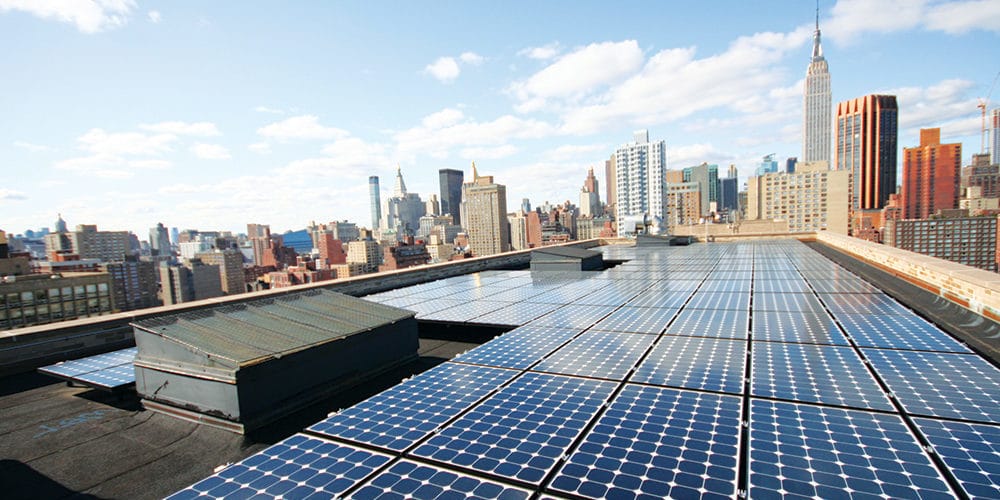The New York State Public Service Commission (PSC) and the New York State Energy Research and Development Authority (NYSERDA) have released a White Paper outlining a roadmap for the state to achieve its 70% by 2030 renewable electricity goal, which was initially enacted in the 2019 Climate Leadership and Community Protection Act.
By 2030 PSC and NYSERDA estimate that the state’s utilities will have to meet an electrical load of 151,678 GWh. That number already accounts for loads served by behind-the-meter resources, like rooftop solar. It also includes 10,334 GWh of additional load from air- and ground-source heat pumps, 9,048 GWh of additional load from electric vehicles and 40,865 GWh of demand reduction from energy efficiency measures.
With that initial estimation of 151,678 GWh in place, by 2030, New York must achieve roughly 106,174 GWh of renewable electricity generation to meet the mandate. For context, the state’s current operating projects and known commitments of projects to come meets about 63,317 GWh annually, leaving the state to make up a difference of 42,858 GWh over the next 10 years.
Par of this demand will be met via an offshore wind procurement schedule that averages around 1 GW annually through 2027, which will lead to roughly 5.8 GW/17,868 GWh generated annually by 2030.
For the remaining 24,990 GWh, PSC and NYSERDA have proposed a mixture of both reforms to the state’s Clean Energy Standard (CES) and additional procurements to meet demand.
Rewriting procurement targets
The first reforms come to the state’s current Tier-1 renewable generation source procurement targets. As it stands, the state needs to add 4,500 GWh of generation every year from 2021 to 2026 to stay in-line with these goals. PSC and NYSERDA have proposed that annual Tier 1 procurements be done in amounts necessary to achieve the 70 by 30 Target, but with the elimination of annual procurement quantity limitations. In explanation of this proposal, the paper outlines:
“NYSERDA should have the flexibility to respond to market conditions, which may mean procuring substantially more or less in any given solicitation than the currently-estimated statewide quantity of 4,500 GWh/year. Instead of the currently-required Minimum and Anticipated Procurement Targets, this White Paper recommends a process in which, by means of the Divergence Test process, NYSERDA annually revises the average annual amount required to reach the 70 by 30 target based on the latest data.”
The two parties also propose the removal of projects of currently viable from counting towards planed capacity expansions; a consolidation and reduction of how heavily project viability, operational flexibility and peak coincidence contribute to a proposed project’s potential; a broadening of the potential risk factors considered for every project proposed and clarification of CES delivery requirements, specifically for energy imported from other states.
Tier 4
The other big change proposed in the White Paper is the establishment of a new Tier 4 within the CES. To be deemed Tier 4, a projects has to prove “demonstrable increased delivery of renewable energy,” with that energy specifically being delivered to New York City. This delivery could come from either projects located directly in NYC or projects that are delivered using a new transmission interconnection into NYC.
Most all renewable generation source would be eligible for this new tier, though some specific restrictions have been added to potential hydroelectric projects. Also, outside of this new tier, the two parties have also proposed expanding New York’s offshore wind procurement mandate to 9 GW by 2035.
Moving forward
The White Paper, now that it has been released, is available for a 60-day public review and comment period. After this period, PSC will act on the submitted recommendations and make a final determination on program design and implementation.
This content is protected by copyright and may not be reused. If you want to cooperate with us and would like to reuse some of our content, please contact: editors@pv-magazine.com.









By submitting this form you agree to pv magazine using your data for the purposes of publishing your comment.
Your personal data will only be disclosed or otherwise transmitted to third parties for the purposes of spam filtering or if this is necessary for technical maintenance of the website. Any other transfer to third parties will not take place unless this is justified on the basis of applicable data protection regulations or if pv magazine is legally obliged to do so.
You may revoke this consent at any time with effect for the future, in which case your personal data will be deleted immediately. Otherwise, your data will be deleted if pv magazine has processed your request or the purpose of data storage is fulfilled.
Further information on data privacy can be found in our Data Protection Policy.